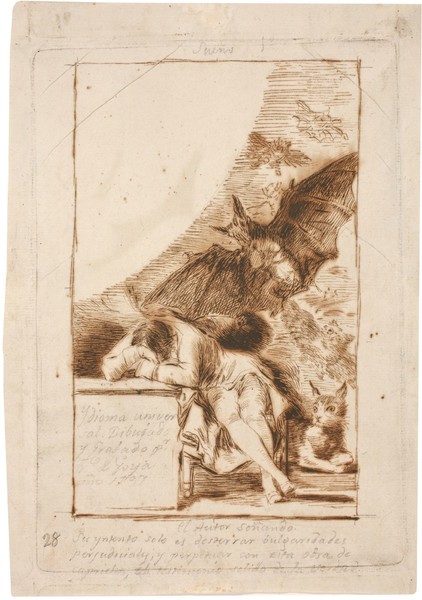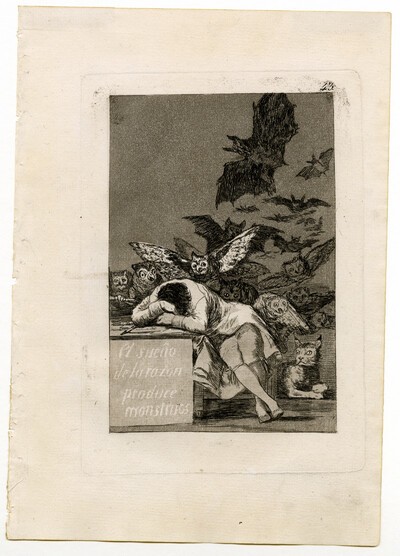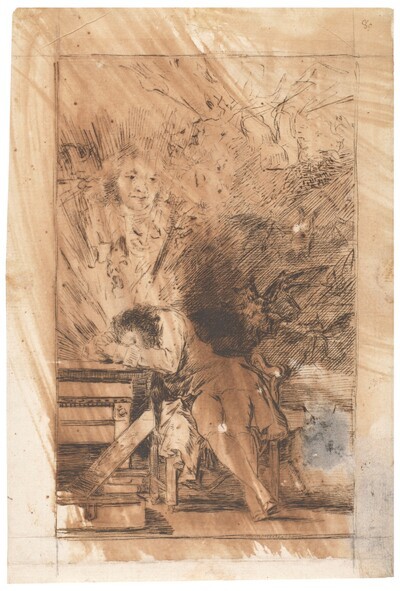- Cronología
- Ca. 1796 - 1797
- Ubicación
- The Prado National Museum. Madrid, Madrid, Spain
- Dimensiones
- 247 x 172 mm
- Técnica y soporte
- Reconocimiento de la autoría de Goya
- Documented work
- Titular
- El Prado National Museum
- Ficha: realización/revisión
- 17 Dec 2010 / 22 Jun 2023
- Inventario
- D. 3923
Sueño 1º (in pencil, recto; upper middle)
Ydioma universal. Dibujado y Grabado pr. Frco. De Goya año 1797 [front of the table] (in pencil, recto; lower left)
El Autor soñando. Su yntento solo es desterrar vulgaridades perjudiciales, y perpetuar con esta obra de caprichos, el testimonio solido de la verdad (in pencil, recto; lower centre)
28 (in pencil, recto; lower left-hand corner)
3 (in red pencil; reverse, centre)
Watermark: H C Wend / & / / Zoonen
The series of drawings known as Dreams is part of the preparatory studies that Goya made for engraving The Caprices, the first germ of which can be found in some of the drawings in Notebook A and Notebook B.
The sheets on which the Dreams are drawn show traces of having been passed through the press, which proves that they were intended to be engraved.
The series begins with Dream 1: Universal Language, as a frontispiece, although in the end its equivalent whim, The Dream of Reason Produces Monsters, was moved to number 43 in the set of engraved prints. The year 1797, which appears in this drawing, is key to the approximate dating of the entire series.
On the death of Francisco de Goya, the twenty-seven known drawings of the Dreams passed successively to his son Javier (+1854) and his grandson Mariano. They were acquired from him around 1861 by the collector and scholar Valentín Carderera. On his death in 1880 they were inherited by his nephew Mariano Carderera, from whom the Museo del Prado bought them by virtue of a Royal Order of 12 November 1886. The subjects they depict correspond to the following Caprices:
Caprice 70 Dream 3 (2 variants, on obverse and reverse)
No equivalence Dream 14
No equivalence Dream 16 (on the reverse side, sketch of the same subject)
Between 1796 and 1797 he produced a series of drawings known as the Dreams, some of which have their starting point in the Notebook B or Madrid Album, in which some of the definitive prints of the Caprices series are defined with absolute fidelity. These drawings were made in pen and then transferred to copper, as the traces of the plate on the paper show, thus serving as a reference for the subsequent etching. This whole process demonstrates Goya's meticulous way of working when producing a series like the Caprices , starting from an idea sketched with brushstrokes, refining and defining the drawing to turn it into a preparatory drawing to be reproduced in the prints.
It was common practice at the time to use dreams as a means of expressing the world under the veil of the artist's imagination, without reference to concrete reality. Likewise, far from depicting specific characters or real situations, these prints are considered to be the fruit of the author's originality.
This is drawing number 1 in the series Dreams, which gives rise to Caprice 43. The Dream of Reason Produces Monsters.
The composition is more simplified than that of the preceding preparatory drawing. He eliminated the copper plate, the paint box and the faces, which were born of his imagination, as well as the donkey and the dog.
Goya portrays himself in the same pose on a simpler table without any tools on it. The title is written on his forehead, and below the drawing is an insiption explaining the meaning of the drawing.
In the upper left corner is a large arc of light emerging from the artist's head, next to it mucielagos and owls flying in the darkness, among which a larger bat with its wings spread out stands out. Next to Goya is the lynx that can be seen in the print, but not the black cat.
It shows traces of having been transferred to copper.
-
The Changing Image: Prints by GoyaMuseum of Fine ArtsBoston1974From October to December 1974. Exhibited also at The National Gallery of Canada, Ottawa, January to March 1975cat. 73
-
Los dibujos de GoyaMuseo Provincial de ZaragozaZaragoza1978exhibition organized by Museo Provincial de Zaragoza, Ministerio de Cultura and Ayuntamiento de Zaragoza, exhibition guide written by Miguel Beltrán Lloris and Micaela Pérez Sáenz. October 1978cat. 27
-
Goya y el espíritu de la IlustraciónMuseo Nacional del PradoMadrid1988from October 6th to December 18th 1988. Exhibited also at Museum of Fine Arts, Boston, January 18th to March 26th 1989; The Metropolitan Museum of Art, Nueva York, May 9th to July 16th 1989, Madrid curator Manuela B. Mena Marqués, scientific directors Alfonso E. Pérez Sánchez and Eleanor A. Sayrecat. 51
-
Goya. La década de Los CaprichosMadrid1992organized by Real Academia de Bellas Artes de San Fernando sponsored by Fundación Central Hispano, Madrid, consultant editor Nigel Glendinnig. From October 26th 1992 to January 10th 1993cat. 6
-
Ydioma universal: Goya en la Biblioteca NacionalBiblioteca NacionalMadrid1996from September 19th to December 15th 1996cat. 121
-
Goya en tiempos de guerraMuseo Nacional del PradoMadrid2008consultant editor Manuela B. Mena Marqués, from April 14th to July 13th 2008cat. 20
-
Goya luces y sombrasCaixaForumBarcelona2012consultant editors José Manuel Matilla and Manuela B. Marqués. From March 16th to June 24th 2012cat. 3
-
Goya: Order and disorderMuseum of Fine ArtsBoston2014cat. 161
-
Madrid2019cat. 3
-
Roma D.Anderson: Editeur1908p. 26, n. 43
-
Los Caprichos de Goya y sus dibujos preparatoriosBarcelonaInstituto Amatller de Arte Hispánico1949p. 87
-
Goya’s Caprichos. Beauty, Reason and CaricatureNueva JerseyPrinceton University Press1953p. 200, fig. 173
-
MadridMuseo del Prado1954n. 41
-
Goya. Los Caprichos. Colección de ochenta y cinco estampas en las que se fustigan errores y vicios humanosMadridEdiciones de Arte y Bibliofilia1966cat. 43
-
Vie et ouvre de Francisco de GoyaParísOffice du livre1970p. 181, cat. 537
-
Goya, 1746-1828. Biografía, estudio analítico y catálogo de sus pinturasBarcelonaEdiciones Polígrafa s.a.1970vol. I, pp. 395, cat. 626
-
Dibujos de Goya, 2 volsBarcelonaNoguer1975p. 76, cat. 39
-
Los Caprichos de Goyacol. Serie punto y líneaBarcelonaGustavo Gili1977p. 118
-
El mundo de Goya en sus dibujosMadridUrbión1979p.7
-
MadridAyuntamiento de Madrid1982pp. 96-97
-
Goya, Saturno y melancolía. Consideraciones sobre el arte de GoyaStockholmAlquimis & Wiksell1962p. 118, fig. 61
-
MadridReal Academia de Bellas Artes de San Fernando1992p. 9, Cat. 6
-
El libro de los caprichos: dos siglos de interpretaciones (1799-1999). Catálogo de los dibujos, pruebas de estado, láminas de cobre y estampas de la primera ediciónMadridMuseo Nacional del Prado1999p. 241
-
MadridMuseo Nacional del Prado1999
-
Goya en tiempos de guerraMadridMuseo Nacional del Prado2008p. 168-169
-
MadridFundación bancaria “la Caixa” y Museo Nacional del Prado2012p.78
-
Goya en Madrid. Cartones para tapices 1775-1794MadridMuseo Nacional del Prado2014p. 229
-
Goya: Order & DisorderBostonMuseum of Fine Arts Boston Publications2014p. 248
-
MadridMuseo Nacional del Prado2019p. 130


